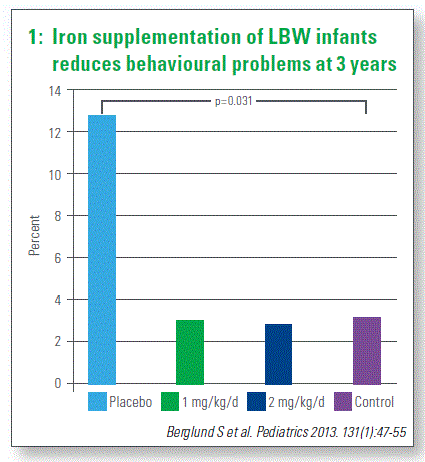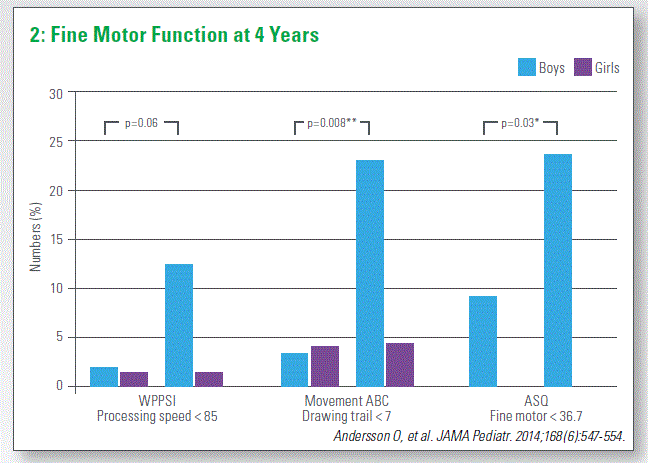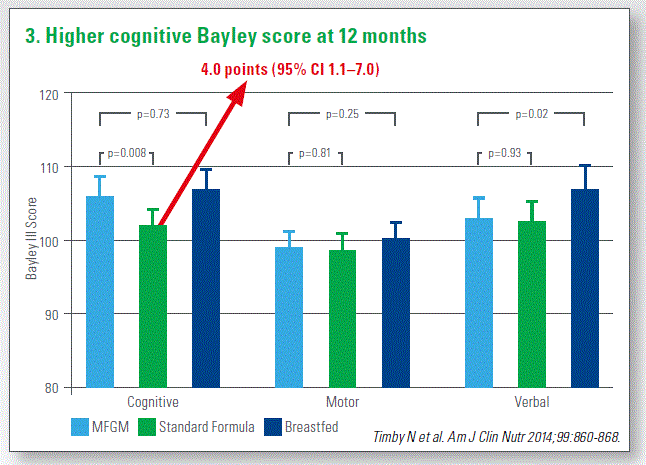Nutrition and Cognition in Term Infants
Nutrition and Cognition in Term Infants
Magnus Domellof
The brain is the fastest growing organ in young children. Furthermore, the brain develops very rapidly during the latter part of gestation and the first 2–3 years of life, and adequate nutrition is essential for the processes of neural proliferation, neural migration, axonal and dendrite growth and arborization, synapse formation and myelination.
Iron deficiency
Iron deficiency (ID) is often stated as the most common nutrient deficiency in the world. Young children are a high-risk group. About 25% of pre-school children have ID anemia and up to 50% in poor areas as South Asia and Africa.
We know from animal studies and observational studies that iron is one of the nutrients which are essential for brain development. There have been numerous intervention studies and a meta-analysis showing that there seems to be an overall effect size of about 2 IQ points (Sachdev, Publ Health Nutr 2005). The most recent Cochrane meta-analysis shows that there is actually no convincing evidence that iron supplement improves motor or mental development in young children with iron deficiency anemia. This implies that prevention iron deficiency is really the most important factor.
We studied this in a high-risk group, which consists of marginally low-birth-weight infants (2,000 – 2,500 grams). This is actually a large proportion: about 3–5% of all newborns or even as much as 15% of neonates in some countries. These infants are usually perceived as healthy. It’s known from previous studies that these babies are at increased risk of behavioral problems and scholastic problems; theoretically, they could have a risk of iron deficiency. We performed the RCT of iron supplements in 285 otherwise healthy infants with generally low birth weight. Intervention from 6 weeks – 6 months was iron drops at 1 or 2 mg/day or placebo. We observed a clear effect on iron status.
In the placebo group, 36% had iron deficiency and 10% had iron deficiency anemia. This was substantially reduced by iron supplementation and there was no IDA at all in the 2 mg group. But the aim was not only to observe the effects on iron status, but also the effects on the actual health of these children. It was very interesting to observe them at 3 years of age using the Achenbach child-behavior checklist. Among those babies who were not supplemented; 13% had behavioral problems, compared to only 3% in the two iron-supplemented groups. This was similar to a group of normal birth weight babies who were not at a high risk of iron deficiency (Chart 1).So this really suggests that prevention of early iron deficiency in this risk group reduces the risk of later behavioral problems. We followed these children up to 7 years of age. These findings were published this year and the same pattern remains.

Delayed Cord Clamping
A totally different way of preventing iron deficiency is to delay the clamping of the umbilical cord at birth. In another RCT, we showed that delayed umbilical cord clamping at delivery of term infants improved early iron status and resulted in improved fine-motor function: 400 low-risk pregnancies were included and the intervention was early cord clam- ping (< 10 sec - ECC) or delayed clamping (> 3 min- DCC). The babies in the delayed clamping group had almost 100 grams heavier birth weight and also significantly higher hemoglobin. We followed those babies and found that at 4 mo there was no longer any difference in hemoglobin, but there were still significant differences in iron status, as well as a difference in the proportion with iron deficiency. Up to 4 years of age, we observed significant effect on fine-motor function in 3 different tests. The differences mostly involved boys (Chart 2).

Iodine
Severe iodine deficiency during pregnancy results in impaired brain development (cretinism) in the offspring. Mild/moderate iodine deficiency in pregnant women has been associated with lower IQ in the offspring at school age. Consumption of iodized salt has decreased; mild iodine deficiency is now common in several European countries, including Sweden.
SWIDDICH Study
We are currently conducting a randomized, controlled trial of iodine supplementation of pregnant Swedish women (n=1,275) to determine whether this will improve cognitive development of their children up to school age. Among the first 200 participants, there is a significant effect on iodine status. This seems to have a good effect on preventing iron deficiency in the mothers. So it remains to be seen if this favorably affects neurodevelopment in the offspring.
Breastfeeding and MFGM
Many observational studies have shown that breastfeeding is associated with higher IQ (about 4 points higher IQ at school age), but the mechanism behind this correlation is unknown. Several components in the breast milk are suspected to have an impact on development. We focused on the milk fat globule membrane (MFGM), which surrounds the lipid droplets that are excreted by the mammary epithelial cells. MFGM is also present in cow’s milk, but it is not present in standard infant formulas, in which the dairy fat is usually discarded and replaced by vegetable fats.
We did RCT of MFGM added to infant formula; 160 babies (0–2 months) were randomized to MFGM formula or standard formula. The intervention lasted until 6 mo and the babies were followed for the first 12 mo. In the Bayley score at 12 mo, the- re was no significant difference between MFGM and standard formula group in the verbal or motor scores, but there was a significant difference in the cognitive domain of the Bayley III test, where the MFGM-supplemented group had a 4 points higher Bayley score. They ended up at the same level as the breastfed control. We are currently following these children to 6 years of age to see if this effect persists (Chart 3)

Which of the MFGM components could cause this mechanism? One component is really interesting: the gangliosides. They comprise 10% of total brain lipids and play a role in the formation of synapses, neural growth and neural function. Brain gangliosides are highest in the prenatal and early postnatal periods. Breastmilk contains gangliosides at significantly higher levels than cow’s-milk-based infant formulas; 32% higher ganglioside-bound sialic acid concentrations were observed in the brains of infants with SIDS compared to breast-fed infants.
There was a small RCT (n= 59) randomized formula with or without supplementation of complex milk lipid to increase ganglioside content to 11–12 µg/mL. Significantly increased ganglioside serum levels were observed; at 6 mo, scores increased (to the level of BF group) for Griffith Scales general score, hand and eye coordination and performance. Of course, it is difficult to measure neurodevelopment at 6 mo, but it goes in the same direction as our study. Looking at the Lipodomics, we have not yet measured gangliosides, but we have measured a lot of lipids and we find a significant difference between the standard formula and the MFGM formula. This requires more studies to elucidate which factor in the MFGM would be responsible for this effect on neurodevelopment.
Conclusions
Early nutritional interventions can influence brain development in term infants
Examples:
- Iodine supplementation of pregnant women (study ongoing)
- Delayed cord clamping at delivery iron
- Iron supplementation of lowbirth weight infants
